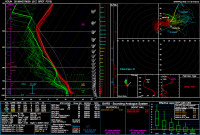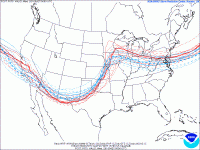Ben Holcomb
EF5
We're officially 1 day within the range of the NAM. The 12Z GFS still maintains a very ominous day in Central Oklahoma into Southern Kansas with not much wavering on the timing or degree of instability. What a time to be chasing!
A quick comparison between the 00z GFS and the 12z GFS, it looks like the 500mb wind max is slightly slower ejecting into the southern plains. If this trend continues it may help to move the target area a little further west into slightly better chase territory. Fingers crossed.
Making the triple point all the more appealing. Windfields concern me just because I've seen systems bust due to placement differences like this.As Warren just mentioned, it does appear that the trend is continuing with the 12z NAM to keep the best upper level flow west of the dryline at 00z. BUT, if the models are over mixing the dryline and she can hang back a bit in western Kansas, that would be excellent. I still think much will change. Also of note on this 12z NAM run is the stronger 850s at 00z are displaced well east in the warm sector, which is not good. But like I said, it will obviously all change again. One thing that should be good from a chasing perspective is that it doesn't look like an obvious target, and chasers should be relatively spread out. That TP, wherever it sets up, is also a very interesting target, if not the primary target.
TA posting rules said:Style and substance
We intend Target Area discussion to be of higher quality than that which occurs elsewhere on the site. This does not mean that all posts must be highly detailed forecasts or only contain high-level meteorological content. It does, however, mean that we would like to avoid meteorologically irrelevant “chatter” (e.g., “Boy, it sure looks like a nice setup next week, but the models are still inconsistent. We’ll get a better idea of the potential as new runs come in”) or posts that contain only readily-accessible content. As such, do not repost weather bulletins unless it's an excerpt and you have substantial information to add. All discussion of other peoples' post content must be constructive and positive. Negative comments (including "most people don't agree with that" and "don't take this the wrong way, but that’s stupid") may not be posted; take this kind of discussion to PM or e-mail. For misleading or inappropriate content, flag the post or contact a moderator and move on. Extraneous chatter is allowed if the post already contains substantial weather discussion and the remarks don't disrupt or derail the thread.


